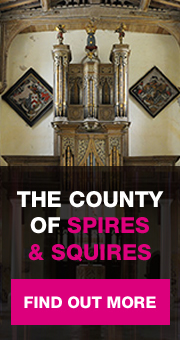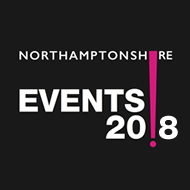However you reach it, Edgcote feels removed from daily life – out of time.
Down a lane you encounter the balanced composition of church & rectory, Manor House, stables & dovecote, all looking out across green fields.
The house was perfected by Richard Chauncey between 1747 – 52 rebuilding his family’s seat. He was also responsible for the splendid set of memorials to himself and his ancestors by Rysbrack that adorn the medieval church.
The building although surrounded by mature trees is light and airy with broad aisles. In its south chapel two early 17th century alabaster tomb chest with effigies of early Chaunceys and their wives, above heraldic stained glass of the same period.
In 1543 the Edgcote estate was leased by Anne of Cleves to William Chauncey ( 1511 – 1585 ), a London lawyer who later bought the property outright. By 1553 he had become Member of Parliament for Northampton: his political rise may well have been secured through the patronage of the Earl of Northumberland.
In the church he is commemorated here with a particularly fine alabaster tomb which shows him lying full length alongside his wife. This stands in the south aisle alongside that of his son Sir Toby Chauncey ( d. 1594 ) and his two wives. The tombs are so alike that it is tempting to think that they were commissioned at the same time from the Roily workshop at Burton on Trent.
Note not only the finely sculpted figures but also the decoration around the tomb chests – a series of children (several in swaddling clothes suggesting early deaths) and some highly unusual shaped balusters. Some original colouring survives. The Royley or Roily workshops were at Chellaston near Burton-on-Trent from where they provided a large number of alabaster tombs in the late 16th century.
For more information on Richard and Gabriel Roily see Jon Bayliss’s article in Church Monuments 1991. Subsequent generations were commemorated less grandly but there are two good 17th century wall tablets nearby. The one to Toby Chauncey ( d. 1662 ) is attributed to Edward Marshall ( 1598 – 1675 ) that versatile sculptor who not only produced monuments and engraved brasses but also worked as a master mason at Northumberland House and Syon for the Earl of Northumberland, as well as at The Vine under the architect John Webb.
The 18th century memorials to the family form part of an interesting commission by Richard Chauncey , a London merchant, who rebuilt Edgcote Manor to the designs of Smith of Warwick between 1747 – 1752 . In the church he employed Michael Rysbrack to carve the family monuments. These are to be found both in the nave and at the rear of the south aisle. The first seems to be to his father Richard Chauncey ( d. 1734 ) but all of them seem to date from the 1740’s. They include that to the children of Toby Chauncey, to another Richard Chauncey, and to Richard Chauncey himself.
Dating from the latter part of Rysbrack‘s career they reflect the sculpture’s search for new commissions/ patrons in the wake of increased metropolitan competition from Scheemaker and Roubiliac.
The falling off of London work was Edgcote’s good fortune. Rysbrack was one of the most important sculptors working in England during the first half of the 18th century. Born in Antwerp in 1694 he trained there with Michael van der Voort before coming to London in 1720. Through James Gibbs the architect he was introduced to his Tory circle of patrons which included Lord Harley, The Duchess of Marlborough and Lord Bolingbroke. Not that this excluded Whig patrons – Robert Walpole at Houghton, Henry Hoare, and his cousin Sir Edward Littleton at Teddesley.
He also got to know William Kent and through him worked for Lord Burlington at Chiswick and for George ll at Kensington Palace. Although his pre eminence diminished in the 1740’s he could still create magnificent works such as the tomb to the 2nd and 3rd Dukes of Beaufort, Badminton in 1754.
At Edgcote it would be interesting to know whether the bust on Richard Chauncey’s memorial in the nave was originally an independent bust added to the monument later. It rather has that feeling. After Richard Chauncey’s death in 1760 the estate passed rapidly through members of the family all of whom are recorded in a fine polychrome tablet that is to be found behind the organ. This type of inlaid work is perhaps more usually found in late 18th century fireplaces, a reminder that jobbing sculptors could put their hands to both.
Beyond it is a splendid late neo–classical wall monument to the eventual successor to the estate Thomas Carter who died in 1835. After Carter’s death the estate passed first to his spinster sister Martha ( d. 1848 ) and thence to her kinswoman and friend Julia Frances Aubrey, second wife of William Ralph Cartwright of Aynho.
The estate then descended in that family who commemorated their deaths in stained glass. That to Julia Frances shows her as a diminutive figure at prayer as does that in the adjacent window to Lady Mary Freemantle, Mrs Richard Cartwright ( d. 1885 ). Both of these windows are to be found in the chancel where you will also discover wall tablets to various rectors and their wives by Hopper, Cakebread and Whitney.
Please refer to the Glossary for any terms in the text that you are unfamiliar with.







